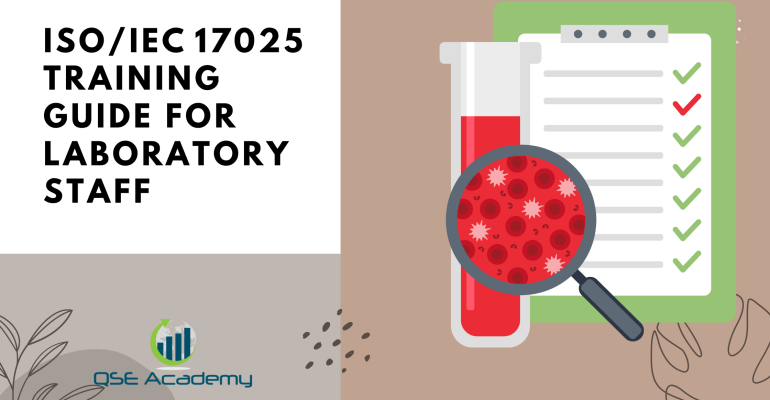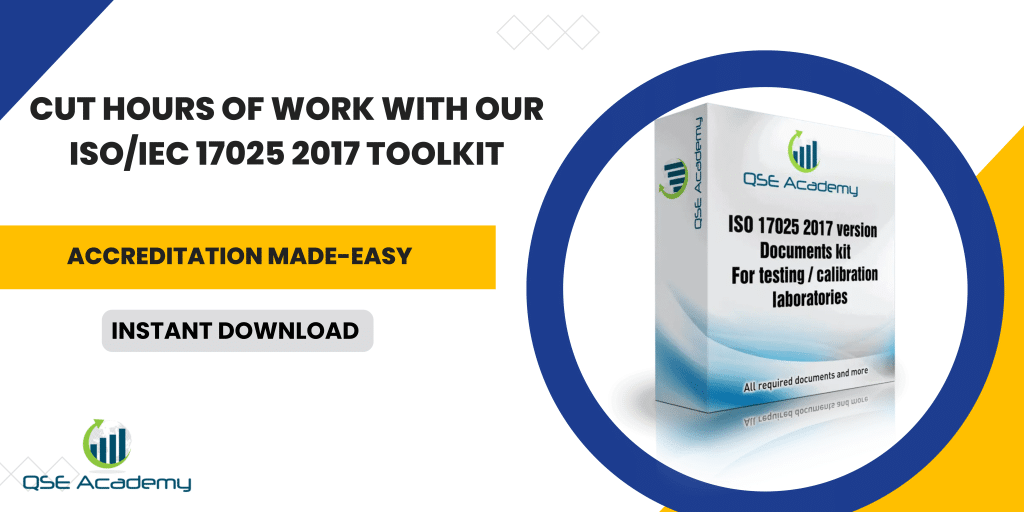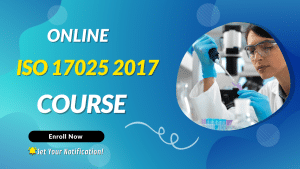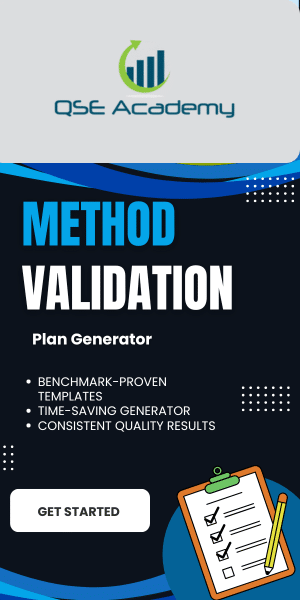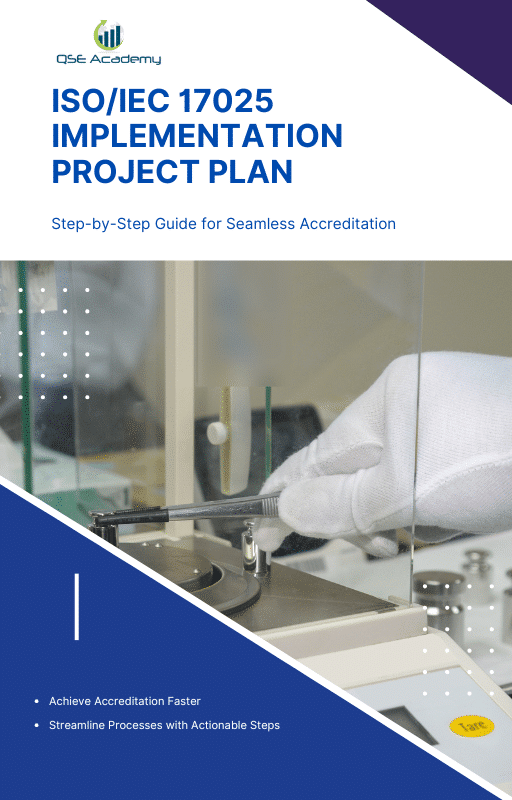ISO/IEC 17025 Training Guide for Laboratory Staff
Last Updated on October 13, 2025 by Melissa Lazaro
Why ISO/IEC 17025 Training Is the Heart of Laboratory Competence
I’ve worked with enough laboratories to notice a pattern: when a lab struggles to maintain ISO/IEC 17025 compliance, it usually isn’t because their equipment fails or their methods are wrong—it’s because their people were never fully trained on why the standard matters or how to apply it in real life.
Training is the foundation of competence. ISO/IEC 17025 Clause 6.2 makes it clear that a laboratory’s credibility rests on the competence of its staff. But here’s the truth—many labs treat training as a “one-and-done” checkbox. They send technicians to a single workshop, collect the attendance certificate, and assume the requirement’s covered.
That approach never works. Real competence is built over time, through structured learning, mentoring, and evidence-based evaluation.
This guide will walk you through how to build and sustain an ISO/IEC 17025-compliant training system that actually works. You’ll learn:
-
What the standard really requires when it says “personnel shall be competent.”
-
How to identify training needs and create a targeted plan.
-
How to evaluate and document competence in a way auditors will respect.
-
And most importantly, how to keep that competence alive year after year.
By the end, you’ll have a clear picture of how to turn training from a formality into one of your lab’s strongest competitive advantages.
Understanding Training & Competence Under ISO/IEC 17025 (Clause 6.2 Explained)
When I first start working with new labs, one of the most common questions I hear is, “What exactly does ISO/IEC 17025 mean by competent personnel?”
It’s a fair question — because competence under this standard isn’t just about having a degree or a few years of experience. It’s about proven ability to perform specific laboratory tasks correctly and consistently.
Clause 6.2 spells this out clearly: every person who influences the validity of test or calibration results must be competent, trained, and authorized. In simple terms, ISO/IEC 17025 expects that everyone doing the work can demonstrate they know what they’re doing, why they’re doing it, and how to do it reliably.
Training vs. Qualification vs. Competence
Let’s clear up three terms that often get mixed up:
-
Qualification – What you bring in: degrees, certificates, or previous job experience.
-
Training – What the lab provides: learning opportunities, mentoring, workshops, or on-the-job coaching.
-
Competence – What you prove: the ability to perform the work according to requirements, validated through observation, records, and results.
A technician might be qualified and trained but still not competent until they’ve demonstrated accuracy and consistency under supervision.
Why This Matters
I once reviewed a calibration lab where technicians were well-qualified but had no formal records showing that anyone had checked their actual measurement performance. During the audit, the assessor asked, “How do you know they’re competent?” The silence that followed said everything.
After that, the lab implemented a structured competence evaluation program — supervisors directly observed technicians performing calibrations, recorded the results, and issued formal authorizations once competence was proven. Their next audit went flawlessly.
Pro Tip
Think of competence as a cycle:
Train → Practice → Evaluate → Authorize → Refresh
It’s ongoing, not a one-time tick box. Whenever you introduce a new method, instrument, or standard, you revisit the cycle.
Common Mistakes to Avoid
-
Assuming experience equals competence. Even senior staff need documented evaluations.
-
Over-relying on certificates. Attendance sheets prove training occurred, not that learning happened.
-
Ignoring retraining. Competence fades if it isn’t refreshed, especially after procedural or method changes.
Identifying Training Needs (Conducting a Competence Gap Assessment)
Here’s something I’ve learned working with laboratories of all sizes — training only works if it targets the right gaps. Too many labs send everyone to the same generic ISO 17025 seminar and call it a day. Then, a few months later, the same issues resurface: calibration errors, incomplete records, and technicians unsure about uncertainty calculations.
That’s because those sessions didn’t address the specific competence gaps in that lab’s daily work.
Start With a Competence Gap Assessment
Before planning any training, you need to understand where your staff stand compared to where they should be.
This is where a competence gap assessment comes in — a simple but powerful exercise that aligns directly with Clause 6.2 requirements.
Ask three basic questions for each role:
-
What knowledge and skills does this person need to perform their job?
-
What do they currently demonstrate or document?
-
What’s missing?
Once you answer those questions, you’ll see exactly where training needs to focus.
Build a Competency Matrix
I like to visualize competence using a competency matrix — a clear, easy-to-read table mapping job roles to required skills. It looks something like this:
| Role | Required Competence | Current Level (1–3) | Training Needed | Target Date |
|---|---|---|---|---|
| Calibration Technician | Uncertainty Calculation | 2 | Advanced training in MU analysis | Nov 2025 |
| Sample Custodian | Sample Traceability | 3 | — | — |
| Quality Manager | Internal Audit Skills | 1 | ISO 17025 Internal Auditor Course | Oct 2025 |
Use a simple 1–3 rating:
-
1 = Basic awareness
-
2 = Working knowledge, needs supervision
-
3 = Fully competent / independent
This visual makes training priorities instantly obvious — you’ll know who needs what, and by when.
Use Data to Identify Hidden Gaps
Don’t rely only on gut feeling. Use evidence to back up your training needs:
-
Internal audit results – Are errors repeating in the same area? That points to a training issue.
-
Proficiency testing results – Consistent performance issues indicate a technical gap.
-
Customer complaints or nonconformities – Often highlight where staff understanding needs reinforcement.
Pro Tip: Add “competence review” as a standing item in your management review meetings. It keeps skills development aligned with real performance data.
Common Mistakes to Avoid
-
One-size-fits-all training: Sending everyone to the same course wastes time and budget.
-
Ignoring soft skills: Communication, reporting, and recordkeeping are just as critical as technical skills.
-
Not linking training to accreditation scope: Only train for what actually affects your accredited parameters.
Designing a Training Plan (Building a Structured Learning Path)
Once you’ve identified your team’s training needs, it’s time to turn that insight into a clear, structured plan.
This is where many labs lose momentum — they know what’s missing but don’t translate it into a strategy with timing, format, and measurable outcomes.
A solid ISO/IEC 17025 training plan bridges that gap. It transforms vague intentions (“We’ll train staff soon”) into an actionable roadmap that auditors and management can track.
Step 1: Define Learning Objectives for Each Role
Start simple. For every staff position, write down what you expect that person to know and demonstrate by the end of the training.
For example:
-
Technician Objective: Accurately perform and record uncertainty calculations for pressure gauge calibrations.
-
Quality Manager Objective: Conduct and document internal audits following ISO/IEC 17025 Clause 8.8.
-
Sample Custodian Objective: Ensure all samples are logged, traceable, and preserved per laboratory policy.
These objectives keep your training focused and measurable.
Pro Tip: Phrase objectives using action verbs — “perform,” “demonstrate,” “analyze,” “verify.” It makes competence easier to evaluate later.
Step 2: Choose the Right Training Methods
Not all learning happens in a classroom. Mix up your methods to fit the skill and context.
Here’s what typically works best for labs:
-
On-the-job training: The fastest, most effective method for technical skills.
-
Classroom or online sessions: Ideal for theory (e.g., uncertainty, method validation).
-
Shadowing / mentoring: Great for new staff or complex equipment.
-
Workshops & simulations: For practical, scenario-based learning.
-
External training / certification: For specialized topics like internal auditing or metrology.
In my experience, the best labs combine these — using internal expertise wherever possible and supplementing with external courses when necessary.
Step 3: Create a Realistic Schedule
Your training plan isn’t a one-time event; it’s a year-round activity.
Here’s a sample outline you can adapt:
| Month | Topic / Skill | Delivery Method | Trainer | Target Audience |
|---|---|---|---|---|
| January | ISO/IEC 17025 Overview & Refresher | Classroom | Quality Manager | All Staff |
| March | Measurement Uncertainty (Advanced) | External Workshop | Metrology Trainer | Calibration Staff |
| June | Internal Audit Skills | Online + Practical | Consultant | QA & Section Heads |
| September | Handling Customer Complaints | On-the-job | Quality Manager | All Staff |
| November | Method Validation Refresher | Workshop | Technical Manager | Testing Staff |
Pro Tip: Align your training schedule with your audit cycle — train before internal and external audits, not after.
Step 4: Define How You’ll Measure Success
A training plan without evaluation is just a calendar.
You need clear performance indicators, such as:
-
Test or quiz results after theoretical sessions.
-
Direct observation of lab work.
-
Successful completion of supervised trials.
-
Reduction in nonconformities tied to that training topic.
Remember — ISO/IEC 17025 doesn’t just ask if you trained people; it asks how you know they became competent as a result.
Common Mistakes to Avoid
-
Overloading your calendar: Too much training too fast leads to fatigue and forgotten lessons.
-
Ignoring follow-ups: Schedule refresher training at least annually.
-
Not documenting learning outcomes: Keep attendance, test results, and evaluation forms for every session.
Delivering Effective Training (Engaging Laboratory Staff)
Here’s something I’ve noticed over and over again: even the best-designed training plan can fall flat if the delivery is dull, disconnected, or purely theoretical.
You can hand out PowerPoint slides all day, but if your team isn’t engaged, they’ll walk away remembering almost nothing.
In ISO/IEC 17025, training isn’t just about transferring knowledge — it’s about building competence through understanding and practice. That means how you deliver training matters just as much as what you teach.
Step 1: Make It Practical and Relevant
Adults learn best when they can immediately see how the training applies to their daily work. So skip the jargon-heavy presentations and focus on real examples from your own lab.
If you’re training on uncertainty calculations, use your actual calibration data.
If you’re reviewing sample handling procedures, walk through real customer cases or nonconformities.
One testing lab I worked with started adding a short “live demo” to every training session — showing, not just explaining, how the process should work. Within two months, their documentation errors dropped by 25%.
Pro Tip: Use your lab’s own forms, equipment, and data during training. The closer it feels to daily work, the faster staff retain it.
Step 2: Encourage Participation
A lecture may check the box, but it doesn’t build competence.
Ask questions, invite staff to share their challenges, and let them demonstrate tasks themselves.
For example:
-
Have technicians explain their own calibration steps out loud.
-
Ask “What could go wrong?” scenarios to prompt problem-solving.
-
Split staff into small groups to practice filling in real records or interpreting uncertainty tables.
Training should feel like a conversation, not a presentation.
Step 3: Use Mentoring and Peer Learning
Some of the best learning happens informally — when an experienced technician coaches a new hire or reviews their work.
Set up a mentorship system within your lab. Pair senior staff with newer employees and give them clear expectations: observe, correct, and sign off once the trainee consistently performs the task correctly.
I once saw a calibration lab formalize this process with “competence buddy checklists.” It not only improved accuracy but also strengthened teamwork.
Step 4: Keep It Short and Consistent
Long, one-time sessions rarely work. Instead, use micro-trainings — short, focused, and frequent sessions that tackle one topic at a time.
A 15-minute “uncertainty refresher” every Friday morning will do more for your lab than a six-hour seminar once a year.
Pro Tip: Rotate trainers. Hearing different perspectives from technical managers, quality leads, and external experts keeps learning dynamic.
Step 5: Reinforce Training Through Daily Work
After each training, supervisors should immediately reinforce what was taught.
If you just completed a session on recordkeeping, spend the next week spot-checking forms and providing feedback.
Training sticks when it’s followed by application.
Common Mistakes to Avoid
-
Relying solely on PowerPoint or theory. Without hands-on engagement, retention drops fast.
-
Ignoring individual learning styles. Some learn by doing, others by observing. Mix your methods.
-
No follow-up checks. Without reinforcement, most training fades within weeks.
Evaluating Competence (Proving Training Effectiveness)
Here’s a truth that surprises many labs — training doesn’t prove competence.
Just because someone attended a session doesn’t mean they learned, understood, or can apply the concepts correctly in real work.
ISO/IEC 17025 Clause 6.2 requires you to evaluate competence — not just record attendance. That means you need tangible evidence that every trained staff member can perform their assigned tasks effectively, independently, and consistently.
Step 1: Define How You’ll Evaluate Competence
Before training even starts, decide how you’ll measure success. Competence evaluation can take many forms:
-
Direct observation: Supervisors watch staff perform tasks and assess accuracy and consistency.
-
Practical demonstrations: Staff complete test runs or calibrations under supervision.
-
Written or oral tests: Useful for theory-based topics like uncertainty or quality procedures.
-
Review of work records: Check real reports, logs, or calibration data for compliance and correctness.
The key is to match your evaluation method to the skill. For example, you can’t test pipette calibration competence with a written quiz — you need to see it done.
Step 2: Use a Competence Evaluation Form
Documenting the evaluation process is essential. I recommend using a simple but structured Competence Evaluation Form, like this:
| Employee Name | Task Evaluated | Evaluation Method | Result (Competent / Needs Improvement) | Evaluator | Date | Comments / Evidence |
|---|---|---|---|---|---|---|
| A. Mendoza | Balance calibration | Observation | Competent | J. Reyes | 10 Sep 2025 | Followed SOP correctly; no errors noted |
| R. Santos | Uncertainty calculation | Practical test | Needs Improvement | Q. Lopez | 12 Sep 2025 | Incorrect unit conversions in example data |
This keeps your evaluation transparent, consistent, and audit-ready.
Step 3: Establish Authorization Levels
Once staff are evaluated, record their authorization status — who can perform, supervise, or verify specific tasks.
For example:
-
Level 1 – Trainee (requires supervision)
-
Level 2 – Authorized Technician (independent)
-
Level 3 – Reviewer / Signatory (approves results)
Display this in a Competence Authorization Matrix. Assessors love seeing that structure because it demonstrates control and accountability.
Step 4: Reassess Competence Regularly
Competence isn’t permanent. It can fade with time, equipment changes, or updated methods.
Schedule reassessments at least annually or whenever a new method, instrument, or standard is introduced.
I once worked with a chemical testing lab that performed brief re-evaluations every six months for critical methods. Over two years, their error rate dropped by half — not because they trained more, but because they verified competence continuously.
Step 5: Address Gaps with Targeted Retraining
If an evaluation identifies a gap, treat it as an opportunity — not a failure.
Plan immediate retraining, document it, and re-evaluate until competence is achieved.
This cycle of train → assess → correct → verify builds a culture of excellence.
Pro Tip
Have evaluations performed by someone independent of the trainee whenever possible — ideally the Technical Manager or a senior authorized person. It prevents bias and strengthens credibility during audits.
Common Mistakes to Avoid
-
Using training attendance as proof of competence. That’s one of the most common ISO 17025 audit findings.
-
Skipping records. “We checked, but didn’t document it” doesn’t satisfy auditors.
-
No defined re-evaluation schedule. Competence must be maintained, not assumed.
Maintaining Training Records (Audit-Ready Documentation)
If there’s one thing ISO/IEC 17025 auditors always ask for, it’s proof.
You can tell them your team is trained and competent—but unless you can show it, it doesn’t count.
That’s why maintaining clean, organized, and up-to-date training records isn’t just good practice—it’s essential for accreditation.
I’ve seen great labs trip up during audits, not because their people were unqualified, but because their records were scattered across emails, personal folders, and old Excel sheets. Let’s make sure that doesn’t happen to you.
Step 1: Know What Auditors Expect to See
Under ISO/IEC 17025 Clause 6.2.5, you must have documented evidence that:
-
Each person’s competence has been evaluated and authorized.
-
Training activities and outcomes are recorded.
-
Retraining occurs when methods, equipment, or job roles change.
So your training files should contain:
-
Training plan or schedule.
-
Attendance sheets or sign-ins.
-
Training materials or presentations used.
-
Competence evaluation results.
-
Authorization forms or matrices.
-
Retraining and refresher logs.
If an auditor asks, “Show me evidence that this technician is competent to calibrate balances,” you should be able to produce all of that in one folder—digital or paper.
Step 2: Create a Centralized Training File or Database
Don’t let each department manage its own spreadsheets.
Centralize everything in one master file or shared folder so updates are easy and visibility is clear.
Here’s what works well for most labs:
| Record Type | Format | Owner | Retention Period |
|---|---|---|---|
| Training Plan | Excel or PDF | Quality Manager | 3 years |
| Attendance Records | Digital sign-in sheet | Document Controller | 3 years |
| Competence Evaluations | PDF / Form | Technical Manager | 5 years |
| Authorization Matrix | Excel Dashboard | Quality Manager | Current version only |
Pro Tip: Use version control just like your procedures—label each file with a revision number and date. Auditors appreciate that consistency.
Step 3: Keep a Training Dashboard
A Training Dashboard makes it easy to see who’s trained, who’s pending, and where refreshers are due.
You can build one in Excel or simple QMS software.
Example columns:
-
Employee Name
-
Role
-
Required Trainings
-
Completed (Y/N)
-
Competence Verified
-
Refresher Due Date
In one calibration lab I worked with, the dashboard was displayed in the break room. Everyone could see their status, which quietly motivated staff to stay current—no chasing required.
Step 4: Review and Update Records Regularly
Training files shouldn’t collect dust.
Review them at least quarterly to ensure:
-
All new hires are included.
-
Completed sessions have attendance and evaluation records.
-
Retraining dates are scheduled before expiry.
Pro Tip: Tie this record review to your management review agenda. That keeps training aligned with performance and audit findings.
Step 5: Prepare for Audit Day
Before an audit, double-check these:
-
Each employee’s file is complete and signed.
-
Authorization matrix reflects current roles.
-
Competence records link directly to methods listed in your accreditation scope.
I once coached a testing lab that color-coded its authorization matrix—green for current, yellow for re-evaluation due, red for expired. The assessor literally said, “This is the cleanest training record system I’ve ever seen.”
Common Mistakes to Avoid
-
Scattered records: Different formats, missing signatures, or incomplete logs.
-
No retraining evidence: Even if the refresher happened verbally, document it.
-
Unlinked evidence: Training without corresponding competence evaluations.
Continuous Improvement in Training (Keeping Competence Alive)
Here’s something I tell every lab I work with: training isn’t a one-time project — it’s a living process.
Competence isn’t static. People change, equipment changes, and methods evolve. If your training system doesn’t evolve too, you’ll eventually drift out of compliance without realizing it.
ISO/IEC 17025 doesn’t just ask you to train your staff — it expects you to review, evaluate, and improve your training process as part of continual improvement (Clause 8.6). Let’s talk about how to make that happen in a practical, sustainable way.
Step 1: Review Training Effectiveness Regularly
Once a year (at minimum), take a step back and ask:
-
Did our training achieve its goals?
-
Did competence levels improve?
-
Have we reduced errors or repeat nonconformities?
-
Are staff confident and consistent in their work?
Use real data to answer these questions — internal audit results, customer feedback, and error trends will tell you more than opinions ever will.
Pro Tip: Keep a “Training Effectiveness Log.” Note down what worked, what didn’t, and how future sessions will change. It shows auditors that your training process is data-driven, not reactive.
Step 2: Use KPIs to Monitor Progress
Quantify your training impact with simple performance indicators, such as:
| KPI | Goal | Measurement Method |
|---|---|---|
| % of staff evaluated as competent | 100% | Competence matrix |
| % of refresher trainings completed on time | ≥ 95% | Training dashboard |
| Reduction in repeat audit findings | ≥ 80% | Internal audit reports |
| % of staff trained on new methods before use | 100% | Training records |
Tracking KPIs gives you hard evidence that your training system is improving over time — and gives management something concrete to discuss in reviews.
Step 3: Learn From Audits and Feedback
Every audit and customer interaction is an opportunity to fine-tune your training system.
If an assessor raises a nonconformity related to personnel or documentation, ask:
-
Was this a training issue?
-
Did we miss a refresher session?
-
Do we need to update our competence criteria?
I’ve seen labs turn minor findings into major improvements simply by integrating them into the next training cycle.
Pro Tip: After every audit, hold a 30-minute “Training Insights” debrief. Ask each department what new lessons or reminders should be built into the next refresher session.
Step 4: Encourage a Learning Culture
The most successful labs don’t train just to pass audits — they train because they value accuracy, safety, and improvement.
Create that culture by:
-
Recognizing staff who mentor others or perform well in evaluations.
-
Including training participation in performance reviews.
-
Encouraging technicians to share best practices during team meetings.
One of my clients, a materials testing lab, introduced “Quality Thursdays” — 15-minute team huddles where one staff member shares a mini-lesson from recent work or a past audit. It became a lab favorite and drastically improved engagement.
Step 5: Integrate Training Review Into the Management System
Add “training performance review” as a standing item in your management review agenda. Discuss:
-
Training completion rates.
-
Competence evaluation results.
-
Identified retraining needs.
-
Effectiveness metrics.
This turns training into a measurable, continual-improvement process — exactly what ISO/IEC 17025 wants to see.
Common Mistakes to Avoid
-
Treating training as a box to tick: Competence needs reinforcement.
-
Ignoring staff input: Technicians often know best where training is needed.
-
Not linking improvements to data: Gut feeling won’t convince an assessor — records will.
FAQs: Common Questions About ISO/IEC 17025 Training for Laboratory Staff
Over the years, I’ve trained and coached dozens of laboratory teams, and no matter the size or scope — from small calibration setups to multi-branch testing labs — the same questions always come up about ISO/IEC 17025 training.
Here are the ones I hear most often, along with straight, experience-based answers.
Q1: How often should laboratory staff receive ISO/IEC 17025 training?
At minimum, training should happen annually, with refreshers whenever new methods, instruments, or procedures are introduced.
However, competence isn’t tied to the calendar — it’s tied to change.
If you’ve updated your uncertainty calculation approach, purchased new calibration equipment, or modified your reporting system, those events all trigger a need for retraining.
Pro Tip: Build a “training trigger” list into your QMS. Anytime one of those triggers happens, a quick review or mini-session keeps competence current and prevents nonconformities later.
Q2: Who is responsible for evaluating staff competence — the Quality Manager or Technical Manager?
Both share responsibility, but in different ways:
-
The Quality Manager ensures the evaluation process follows ISO/IEC 17025 and that records are complete and controlled.
-
The Technical Manager verifies the actual technical competence — whether the person can perform the test or calibration correctly and confidently.
Think of it as partnership: Quality handles system consistency, Technical ensures scientific integrity.
Q3: Can we deliver ISO/IEC 17025 training internally, or should we hire external trainers?
You can absolutely deliver training internally — and in many cases, that’s the best way.
Internal training ensures relevance because you’re teaching your staff with your own methods, instruments, and data.
That said, external trainers are useful for:
-
Complex or specialized topics (like measurement uncertainty or root cause analysis).
-
Introducing new perspectives or interpretations.
-
Refreshing competence before a major accreditation audit.
In my experience, the most effective programs blend both: internal sessions for daily operations, and periodic external training for deeper technical development.
Q4: How do we prove that our training is effective?
Simple — you need evidence of improvement.
This could be:
-
Updated competence evaluation records.
-
Reduced audit findings.
-
Consistent proficiency testing results.
-
Positive internal audit feedback.
Pro Tip: Track trends. If you can show that error rates or audit findings dropped after training, that’s undeniable proof your training works — and auditors will take note.
By far, it’s “no evidence of competence evaluation.”
Labs often show attendance certificates but forget to document actual performance verification.
The fix is simple: always follow up training with evaluation — observation, testing, or performance review — and record it.
Building a Culture of Competence Through ISO/IEC 17025 Training
If there’s one message I’d leave with any laboratory team, it’s this: your people are your quality system.
You can have the best procedures, the newest instruments, and a polished quality manual — but without competent, confident staff who truly understand ISO/IEC 17025, none of it will last.
Training isn’t just a requirement; it’s the foundation of reliability. It’s what turns theory into consistency, and consistency into credibility.
Key Takeaways
Here’s what we’ve covered:
-
ISO/IEC 17025 training isn’t optional — it’s continuous. Competence needs to be developed, proven, and refreshed regularly.
-
Every lab role requires clarity. Define what competence looks like for technicians, quality staff, and management.
-
Training should be relevant and practical. Real lab data, real scenarios, real feedback — that’s how lessons stick.
-
Records matter. Keep proof of training, evaluations, and authorizations — they’re your safety net during audits.
-
Continual improvement keeps you sharp. Use data, audit results, and feedback to evolve your training system year after year.
Real-World Perspective
I’ve worked with labs that treated training as an expense, and others that treated it as an investment. The difference?
The second group built teams that rarely stumbled in audits, delivered consistent results, and could adapt to new standards with ease.
Those labs didn’t chase compliance — they built competence into their culture.
Your Next Step
If you’re ready to strengthen your laboratory team’s capability and ensure your training system fully meets ISO/IEC 17025 requirements:
Download the ISO/IEC 17025 Training Plan & Competence Matrix Template – a ready-to-use toolkit to build and track staff training across all roles.
Or consult with our ISO/IEC 17025 experts – QSE Academy’s consultants can help you design a tailored training and evaluation framework built around your lab’s real work, not generic theory.
Because in the end, accreditation isn’t achieved through paperwork — it’s earned through people who know exactly what they’re doing, and why it matters.
I hold a Master’s degree in Quality Management, and I’ve built my career specializing in the ISO/IEC 17000 series standards, including ISO/IEC 17025, ISO 15189, ISO/IEC 17020, and ISO/IEC 17065. My background includes hands-on experience in accreditation preparation, documentation development, and internal auditing for laboratories and certification bodies. I’ve worked closely with teams in testing, calibration, inspection, and medical laboratories, helping them achieve and maintain compliance with international accreditation requirements. I’ve also received professional training in internal audits for ISO/IEC 17025 and ISO 15189, with practical involvement in managing nonconformities, improving quality systems, and aligning operations with standard requirements. At QSE Academy, I contribute technical content that turns complex accreditation standards into practical, step-by-step guidance for labs and assessors around the world. I’m passionate about supporting quality-driven organizations and making the path to accreditation clear, structured, and achievable.

